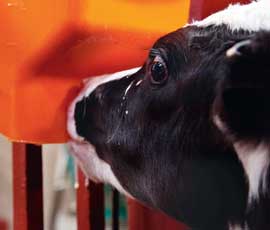The latest calf feeding results

What are the benefits of computerised calf feeding and what are the arguments for upping milk replacer levels? Harper Adams senior lecturer Simon Marsh runs through the University’s latest calf rearing trial findings.
(1) Computerised machine feeding systems
The experiment:
Calves were reared either on a traditional individual bucket rearing system feeding five litres of milk based on calf milk powder (CMR) mixed at 12.5% strength (625g/CMR/day) to weaning at six weeks, or the same quantity of CMR fed to calves reared in a group on a computerised machine.
Key findings:
- No difference in calf performance
- From a behaviour study it could be suggested that the group- reared calves were more content
- Labour was reduced by 53% with the computerised machine reared calves. If labour is costed at £10/hour to rear calves and if a machine costs £7,000 then rearing more than 520 calves will cover its cost.
(2) Once-a-day milk replacer feeding systems
The experiment:
We have now carried out two experiments feeding calves either once or twice a day with CMR – not whole milk. In both experiments, the calves were fed the same quantity of CMR, for example, three litres a day of milk mixed at 20% strength fed once, or five litres mixed at 12% strength given in two feeds.
In the first study, the calves started on the once-a-day feeding at five days old and recorded significantly poorer performance. This supports the legal position on once-a-day feeding of milk to calves outlined in the Code of Recommendations for the Welfare of Livestock. This states that it is illegal to feed calves under four weeks of age once a day with milk.
In the second study, calves were a month old at the start of the experiment and the once-a-day calves recorded improved performance
Key findings:
- Consider once-a-day feeding on milk powder-based regimes with calves over four weeks old (as outlined by the Welfare Code)
- On once-a-day systems, milk is fed with a higher concentration/mix rate of CMR. Feeding whole milk is therefore not suitable
- Labour inputs were reduced by 42-49% with once-a-day feeding
- Once-a-day feeding needs a high level of stockmanship to identify any calves that are not thriving.
(3) Feeding elevated levels of milk powder
The experiment:
Standard recommendations with milk powder systems are to feed 500g a day of CMR. We have investigated feeding an increased level of 750g to calves.
Key findings:
- Calves fed the higher levels of CMR recorded improved performance, which continued through to 11 weeks at the end of the trial, in other words, the calves fed the lower level of CMR did not exhibit compensatory growth.
- We are running another trial and a preliminary analysis of the data would appear to show similar results.
- State advisory service Teagasc has evaluated feeding markedly higher levels of CMR comparing 600g v 1,200g, the latter being virtually equivalent to feeding ad lib milk. Weaning weights were increased from 62.7 to 71.6kg but by 270 days of age there was no difference in weight. The calves fed the very high level of CMR recorded a major growth check at weaning since they were not used to eating concentrates. Getting calves to eat starter pellets is vitally important. Work in the USA at Penn State University showed concentrates stimulate rumen development in a calf – not forage.
(4) Starter concentrates feed rate and quality
The experiment:
Feeding calves an 18% crude protein starter concentrate from a week old is also a standard recommendation and we have compared various feed types and weaning strategies.
Key findings:
- Calves were weaned when eating either 0.75kg or 1.25kg of starter pellets for three consecutive days. It was concluded that the current recommendation of weaning calves when concentrate intake has reached 1.0kg a day should remain.
- When a coarse mix was compared to 3mm pellets DLWGs were significantly improved with the 3mm pellets. Since coarse mixes are typically £70/t more expensive major savings were made on feed costs
- When a 3mm pellet was compared to a 6mm nut with an identical formulation the calves fed the 6mm nut recorded significantly improved DLWGs.
- Both of the above trial results will come as a surprise to many calf rearers
Two calf trials are carried out each year at Harper Adams. The studies involve batches of 40-50 dairy-bred bull calves that are reared on production-based experiments to 12 weeks old. Despite being carried out with bull calves the results will be applicable to dairy-bred heifers.
